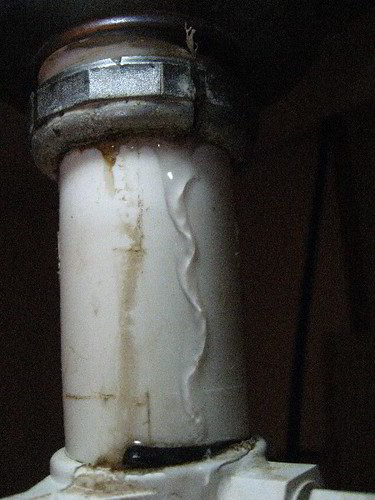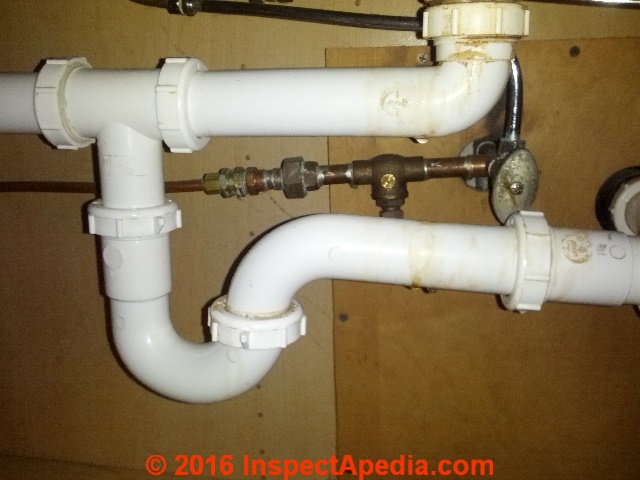Dealing with a Leak Under Your Kitchen Sink Drain
Discovering a leak under your kitchen sink drain can be a frustrating experience, but it’s a common issue that many homeowners face at some point. Whether it’s a slow drip or a sudden puddle, a leak under the sink can lead to water damage, mold growth, and unpleasant odors if not addressed promptly. Today we will discuss and explore the causes of kitchen sink drain leaks, step-by-step troubleshooting methods, repair solutions, and preventive measures to keep your kitchen dry and leak-free.

The Causes of Kitchen Sink Drain Leaks
Before diving into troubleshooting and repairs, it’s essential to understand the potential causes of a leak under your kitchen sink drain. Common culprits include:
Loose Connections: Over time, the connections between the various components of the kitchen sink drain, such as the P-trap, slip nuts, and tailpiece, can become loose due to regular use or vibrations. Loose connections can allow water to seep out and cause leaks.
Worn Gaskets or Seals: The rubber gaskets or seals that create a watertight seal between the different parts of the sink drain assembly can deteriorate over time, leading to leaks. Check these components for signs of wear, cracking, or damage.
Corrosion: If your kitchen sink drain is made of metal, such as brass or steel, corrosion can occur over time, especially in areas with hard water. Corrosion can weaken the integrity of the drain components and result in leaks.
Clogs: A buildup of grease, food particles, or debris in the drain pipes can cause blockages, leading to pressure buildup and potential leaks. Clogs can also contribute to foul odors emanating from the sink.

Troubleshooting and Repairing Kitchen Sink Drain Leaks
When faced with a leak under your kitchen sink drain, follow these steps to identify the source of the leak and implement the necessary repairs:
Inspect for Visible Leaks: Start by visually inspecting the area under the sink for any signs of water accumulation, dampness, or staining. Trace the source of the leak back to its origin, checking the connections, joints, and components of the drain assembly.
Tighten Loose Connections: Using a wrench or pliers, carefully tighten any loose connections, including slip nuts, compression fittings, and threaded joints. Avoid over-tightening, as this can damage the components or strip the threads.
Replace Worn Gaskets or Seals: If you identify a worn or damaged gasket or seal, remove the affected component and replace it with a new one. Ensure that the replacement gasket or seal is compatible with your sink drain assembly and provides a proper seal.
Clean the Drain Pipes: If a clog is suspected as the cause of the leak, use a plunger or plumber’s snake to clear any obstructions from the drain pipes. Alternatively, a commercial drain cleaner can help dissolve stubborn clogs but use caution and follow the manufacturer’s instructions carefully.

Preventive Measures to Avoid Future Leaks
Once you’ve addressed the leak under your kitchen sink drain, take proactive steps to prevent future leaks and maintain the integrity of your plumbing system:
Regular Maintenance: Schedule periodic inspections of your kitchen sink drain and plumbing system to check for any signs of leaks, corrosion, or damage. Addressing minor issues early can prevent them from escalating into major problems.
Avoid Overloading the Sink: Be mindful of what goes down the kitchen sink drain and avoid disposing of grease, oil, coffee grounds, and large food particles that can contribute to clogs and drainage issues.
Use Drain Strainers: Install drain strainers or guards in the sink drains to catch debris and prevent it from entering the drain pipes. Clean the drain strainers regularly to ensure proper flow and drainage.
Monitor Water Pressure: Excessive water pressure can strain the plumbing connections and contribute to leaks. Install a pressure regulator if necessary and keep an eye on the water pressure to maintain it within safe levels.

Common Mistakes to Avoid
When dealing with a leak under your kitchen sink drain, avoid the following common mistakes:
Ignoring Minor Leaks: Even a small drip can indicate an underlying issue that requires attention. Ignoring minor leaks can lead to water damage, mold growth, and costly repairs down the line.
Using Excessive Force: When tightening connections or disassembling the drain assembly, avoid using excessive force, as this can damage the components or strip the threads. Use the appropriate tools and apply gentle pressure as needed.
Neglecting Regular Maintenance: Skipping routine maintenance of your kitchen sink drain and plumbing system can result in undetected leaks and preventable issues. Stay proactive and schedule periodic inspections and maintenance tasks.
Using Incorrect Materials: When replacing gaskets, seals, or other components of the sink drain assembly, ensure that you use materials that are compatible with your plumbing system and provide a proper seal. Using incorrect materials can lead to leaks and further damage.
Failing to Seek Professional Help: If you’re unsure about how to diagnose or repair a leak under your kitchen sink drain, don’t hesitate to seek professional assistance from a licensed plumber. Attempting DIY repairs without the necessary expertise can worsen the problem and lead to costly repairs.

Why is there water leaking under my kitchen sink drain?
Water leaking under the kitchen sink drain can be caused by loose connections, worn gaskets or seals, corrosion, or clogs in the drain pipes. Inspect the area carefully to identify the source of the leak and implement the necessary repairs.
How can I prevent leaks under my kitchen sink drain?
To prevent leaks under the kitchen sink drain, practice regular maintenance, avoid overloading the sink with grease or food particles, use drain strainers, monitor water pressure, and address minor issues promptly.
Can I use a chemical drain cleaner to unclog a kitchen sink drain?
While chemical drain cleaners can dissolve clogs, they can also damage the pipes and plumbing fixtures if used improperly. Exercise caution and follow the manufacturer’s instructions when using chemical drain cleaners.
What should I do if I can’t stop the leak under my kitchen sink drain?
If you’re unable to stop the leak under your kitchen sink drain despite your efforts, consider seeking professional help from a licensed plumber. A plumber can diagnose the issue accurately and implement the necessary repairs or replacements.
Is it normal for the kitchen sink drain to emit foul odors?
Foul odors emanating from the kitchen sink drain can indicate the presence of food debris, grease buildup, or bacterial growth. Clean the drain pipes regularly and use odor-neutralizing products to eliminate unpleasant smells.

How To Fix Leaking Sink

Kitchen-Sink-Drain-Leak-Repair-Guide-013
Fix a Leaky Sink – Old House Journal Magazine
Kitchen-Sink-Drain-Leak-Repair-Guide-001
Kitchen-Sink-Drain-Leak-Repair-Guide-003
New Kitchen Drain I installed a garbage disposal in hopes … Flickr

How to Replace a Kitchen Sink Basket Strainer Sink basket, Diy plumbing, Plumbing

Drain piping under kitchen sink leaking badly

Related Posts:
- Kitchen Sinks And Taps Reviews
- Under Kitchen Sink Pull Out Trash Can
- Most Popular Kitchen Sinks Now
- Stainless Steel Kitchen Sink Inserts
- How To Remove Kitchen Sink Drain Cover
- Small Kitchen Sink Dish Drainer
- Franke Kitchen Sink Price
- Top Mount Granite Composite Kitchen Sinks
- Large Stainless Steel Undermount Kitchen Sinks
- Aldi Kitchen Sink Taps